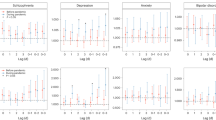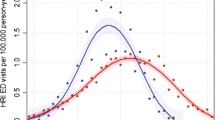Abstract
Relatively few studies investigated the effects of extreme temperatures (both heat and cold) on mental health (ICD-9: 290-319; ICD-10: F00-F99) and the potential effect modifications by individuals’ age, sex, and race. We aimed to explore the effect of extreme temperatures of both heat and cold on the emergency room (ER) visits for mental health disorders, and conducted a stratified analysis to identify possible susceptible population in Erie and Niagara counties, NY, USA. To assess the short-term impacts of daily maximum temperature on ER visits related to mental disorders (2009–2015), we applied a quasi-Poisson generalized linear model combined with a distributed lag non-linear model (DLNM). The model was adjusted for day of the week, precipitation, long-term time trend, and seasonality. We found that there were positive associations between short-term exposure to extreme ambient temperatures and increased ER visits for mental disorders, and the effects can vary by individual factors. We found heat effect (relative risk (RR) = 1.16; 95% confidence intervals (CI), 1.06–1.27) on exacerbated mental disorders became intense in the study region and subgroup of population (the elderly) being more susceptible to extreme heat than any other age group. For extreme cold, we found that there is a substantial delay effect of 14 days (RR = 1.25; 95% CI = 1.08–1.45), which is particularly burdensome to the age group of 50–64 years old and African-Americans. Our findings suggest that there is a positive association between short-term exposure to extreme ambient temperature (heat and cold) and increased ER visits for mental disorders, and the effects vary as a function of individual factors, such as age and race.



Similar content being viewed by others
Data availability
The datasets (emergency room visits) analyzed during the current study are not publicly available due to the privacy of patients.
References
Almendra R, Loureiro A, Silva G, Vasconcelos J, Santana P (2019) Short-term impacts of air temperature on hospitalizations for mental disorders in Lisbon. Sci Total Environ 647:127–133
Anderson GB, Bell ML (2011) Heat waves in the United States: mortality risk during heat waves and effect modification by heat wave characteristics in 43 us communities. Environ Health Perspect 119(2):210–218
Berry HL, Waite TD, Dear K, Capon AG, Murray V (2018) The case for systems thinking about climate change and mental health. Nat Clim Change 8(4):282–290
Carlsen HK, Oudin A, Steingrimsson S (2019) Ambient temperature and associations with daily visits to a psychiatric emergency unit in Sweden. Int J Environ Res Public Health 16(2):286
Chan EY, Lam HC, So SH, Goggins WB, Ho JY, Liu S, Chung PP (2018) Association between ambient temperatures and mental disorder hospitalizations in a subtropical city: a time-series study of Hong Kong special administrative region. Int J Environ Res Public Health 15(4):754
Chen C, Liu C, Chen R, Wang W, Li W, Kan H, Fu C (2018a) Ambient air pollution and daily hospital admissions for mental disorders in Shanghai, China. Sci Total Environ 613:324–330
Chen K, Breitner S, Wolf K, Hampel R, Meisinger C, Heier M, von Scheidt W, Kuch B, Peters A, Schneider A et al (2019) Temporal variations in the triggering of myocardial infarction by air temperature in Augsburg, Germany, 1987–2014. Eur Heart J 40(20):1600–1608
Chen K, Wolf K, Breitner S, Gasparrini A, Stafoggia M, Samoli E, Andersen ZJ, Bero-Bedada G, Bellander T, Hennig F et al (2018b) Two-way effect modifications of air pollution and air temperature on total natural and cardiovascular mortality in eight European urban areas. Environ Int 116:186–196
Conti S, Masocco M, Meli P, Minelli G, Palummeri E, Solimini R, Toccaceli V, Vichi M (2007) General and specific mortality among the elderly during the 2003 heat wave in Genoa (Italy). Environ Res 103(2):267–274
Cornali C, Franzoni S, Riello R, Ghianda D, Frisoni GB, Trabucchi M (2004) Effect of high climate temperature on the behavioral and psychological symptoms of dementia. J Am Med Dir Assoc 5(3):161–166
Gasparrini A (2011) Distributed lag linear and non-linear models in R: the package dlnm. J Stat Softw 43(8):1–20
Gasparrini A (2014) Modeling exposure–lag–response associations with distributed lag non-linear models. Stat Med 33(5):881–899
Gasparrini A, Guo Y, Hashizume M, Kinney PL, Petkova EP, Lavigne E, Zanobetti A, Schwartz J, Tobias A, Leone M et al (2015a) Temporal variation in heat–mortality associations: a multicountry study. Environ Health Perspect 123(11):1200–1207
Gasparrini A, Guo Y, Hashizume M, Lavigne E, Zanobetti A, Schwartz J, Tobias A, Tong S, Rocklöv J, Forsberg B et al (2015b) Mortality risk attributable to high and low ambient temperature: a multicountry observational study. Lancet 386(9991):369–375
Guo Y, Gasparrini A, Armstrong B, Li S, Tawatsupa B, Tobias A, Lavigne E, Coelho M. d. S. Z. S., Leone M, Pan X et al (2014) Global variation in the effects of ambient temperature on mortality: a systematic evaluation. Epidemiology (Cambridge Mass.) 25(6):781
Hansen A, Bi P, Nitschke M, Ryan P, Pisaniello D, Tucker G (2008) The effect of heat waves on mental health in a temperate Australian city. Environ Health Perspect 116(10):1369–1375
Ho HC, Wong MS (2019) Urban environmental influences on the temperature–mortality relationship associated mental disorders and cardiorespiratory diseases during normal summer days in a subtropical city. Environ Sci Pollut Res 26(23):24272–24285
James SL, Abate D, Abate KH, Abay SM, Abbafati C, Abbasi N, Abbastabar H, Abd-Allah F, Abdela J, Abdelalim A et al (2018) Global, regional, and national incidence, prevalence, and years lived with disability for 354 diseases and injuries for 195 countries and territories, 1990–2017: a systematic analysis for the global burden of disease study 2017. Lancet 392(10159):1789–1858
Jones R, Lin S, Munsie JP, Radigan M, Hwang S-A (2008) Racial/ethnic differences in asthma-related emergency department visits and hospitalizations among children with wheeze in Buffalo, New York. J Asthma 45(10):916–922
Khalaj B, Lloyd G, Sheppeard V, Dear K (2010) The health impacts of heat waves in five regions of New South Wales, Australia: a case-only analysis. Int Arch Occup Environ Health 83(7):833–842
Kim Y, Kim H, Gasparrini A, Armstrong B, Honda Y, Chung Y, Ng CFS, Tobias A, Íñiguez C, Lavigne E et al (2019) Suicide and ambient temperature: a multi-country multi-city study. Environ Health Perspect 127(11):117007
Kim Y, Kim H, Honda Y, Guo Y, Chen B-Y, Woo J-M, Ebi K (2016) Suicide and ambient temperature in East Asian countries: a time-stratified case-crossover analysis. Environ Health Perspect 124(1):75–80
Lee S, Lee H, Myung W, Kim EJ, Kim H (2018) Mental disease-related emergency admissions attributable to hot temperatures. Sci Total Environ 616:688–694
Li H, Zhang S, Qian ZM, Xie X. -H., Luo Y, Han R, Hou J, Wang C, McMillin SE, Wu S et al (2020) Short-term effects of air pollution on cause-specific mental disorders in three subtropical Chinese cities. Environ Res 191:110214
Lorenz R, Stalhandske Z, Fischer EM (2019) Detection of a climate change signal in extreme heat, heat stress, and cold in Europe from observations. Geophys Res Lett 46(14):8363–8374
Lu P, Zhang Y, Xia G, Zhang W, Xu R, Wang C, Guo Y, Li S (2020) Attributable risks associated with hospital outpatient visits for mental disorders due to air pollution: a multi-city study in china. Environ Int 143:105906
Luber G, McGeehin M (2008) Climate change and extreme heat events. Am J Prevent Med 35(5):429–435
Ma Y, Zhou L, Chen K (2020) Burden of cause-specific mortality attributable to heat and cold: a multicity time-series study in Jiangsu Province, China. Environ Int 144:105994
Maes M, Scharpé S, Verkerk R, D’Hondt P, Peeters D, Cosyns P, Thompson P, De Meyer F, Wauters A, Neels H (1995) Seasonal variation in plasma L-tryptophan availability in healthy volunteers: relationships to violent suicide occurrence. Arch Gen Psychiatry 52(11):937–946
Martin-Latry K, Goumy M-P, Latry P, Gabinski C, Bégaud B, Faure I, Verdoux H (2007) Psychotropic drugs use and risk of heat-related hospitalisation. Eur Psychiatry 22(6):335–338
Meehl GA, Tebaldi C (2004) More intense, more frequent, and longer lasting heat waves in the 21st century. Science 305(5686):994–997
Min M, Shi T, Ye P, Wang Y, Yao Z, Tian S, Zhang Y, Liang M, Qu G, Bi P et al (2019) Effect of apparent temperature on daily emergency admissions for mental and behavioral disorders in Yancheng, China: a time-series study. Environ Health 18(1):98
Mora C, Dousset B, Caldwell IR, Powell FE, Geronimo RC, Bielecki CR, Counsell CW, Dietrich BS, Johnston ET, Louis LV et al (2017) Global risk of deadly heat. Nat Clim Change 7(7):501–506
Ogawa S, Fujii T, Koga N, Hori H, Teraishi T, Hattori K, Noda T, Higuchi T, Motohashi N, Kunugi H (2014) Plasma L-tryptophan concentration in major depressive disorder: new data and meta-analysis. J Clin Psychiatry 75(9):906–915
Page LA, Hajat S, Kovats RS (2007) Relationship between daily suicide counts and temperature in England and Wales. Br J Psychiatry 191(2):106–112
Page LA, Hajat S, Kovats RS, Howard LM (2012) Temperature-related deaths in people with psychosis, dementia and substance misuse. Br J Psychiatry 200(6):485–490
Pan R, Zhang X, Gao J, Yi W, Wei Q, Xu Z, Duan J, Bai L, Cheng Q, Zhang Y et al (2019) Impacts of heat and cold on hospitalizations for schizophrenia in Hefei, China: an assessment of disease burden. Sci Total Environ 694:133582
Patterson KL, Yoo E. -H. (2012) Trapped in poor places? An assessment of the residential spatial patterns of housing choice voucher holders in 2004 and 2008. J Soc Serv Res 38(5):637–655
Peng Z, Wang Q, Kan H, Chen R, Wang W (2017) Effects of ambient temperature on daily hospital admissions for mental disorders in Shanghai, China: a time-series analysis. Sci Total Environ 590:281–286
Raja S, Ma C, Yadav P (2008) Beyond food deserts: measuring and mapping racial disparities in neighborhood food environments. J Plan Educ Res 27(4):469–482
Rocklöv J, Forsberg B, Ebi K, Bellander T (2014) Susceptibility to mortality related to temperature and heat and cold wave duration in the population of Stockholm County, Sweden. Global Health Action 7(1):22737
Shiloh R, Hermesh H, Weizer N, Dorfman-Etrog P, Weizman A, Munitz H (2000) Acute antipsychotic drug administration lowers body temperature in drug-free male schizophrenic patients. Eur Neuropsychopharmacol 10(6):443–445
Tong L, Li K, Zhou Q (2016) Season, sex and age as modifiers in the association of psychosis morbidity with air pollutants: a rising problem in a Chinese metropolis. Sci Total Environ 541:928–933
Trang PM, Rocklöv J., Giang KB, Kullgren G, Nilsson M (2016) Heatwaves and hospital admissions for mental disorders in northern Vietnam. PloS One 11(5):e0155609
Walker G, Day R (2012) Fuel poverty as injustice: integrating distribution, recognition and procedure in the struggle for affordable warmth. Energy policy 49:69–75
Wang X, Lavigne E, Ouellette-kuntz H, Chen BE (2014) Acute impacts of extreme temperature exposure on emergency room admissions related to mental and behavior disorders in Toronto, Canada. J Affect Disord 155:154–161
Wang X, Wang W, Jiao S, Yuan J, Hu C, Wang L (2018) The effects of air pollution on daily cardiovascular diseases hospital admissions in Wuhan from 2013 to 2015. Atmos Environ 182:307–312
Watts N, Amann M, Ayeb-Karlsson S, Belesova K, Bouley T, Boykoff M, Byass P, Cai W, Campbell-Lendrum D, Chambers J et al (2018) The Lancet countdown on health and climate change: from 25 years of inaction to a global transformation for public health. Lancet 391(10120):581–630
Williams S, Nitschke M, Sullivan T, Tucker GR, Weinstein P, Pisaniello DL, Parton KA, Bi P (2012) Heat and health in Adelaide, South Australia: assessment of heat thresholds and temperature relationships. Sci Total Environ 414:126–133
Wu Z, Chen X, Li G, Tian L, Wang Z, Xiong X, Yang C, Zhou Z, Pan X (2020) Attributable risk and economic cost of hospital admissions for mental disorders due to PM2.5 in Beijing. Sci Total Environ 718:137274
Xue T, Zhu T, Zheng Y, Zhang Q (2019) Declines in mental health associated with air pollution and temperature variability in china. Nat Commun 10(1):1–8
Zeka A, Zanobetti A, Schwartz J (2006) Individual-level modifiers of the effects of particulate matter on daily mortality. Am J Epidemiol 163(9):849–859
Zhang S, Yang Y, Xie X, Li H, Han R, Hou J, Sun J, Qian ZM, Wu S, Huang C et al (2020) The effect of temperature on cause-specific mental disorders in three subtropical cities: a case-crossover study in China. Environ Int 143:105938
Zhao T, Markevych I, Romanos M, Nowak D, Heinrich J (2018) Ambient ozone exposure and mental health: a systematic review of epidemiological studies. Environ Res 165:459–472
Author information
Authors and Affiliations
Corresponding author
Ethics declarations
Conflict of interest
The authors declare no competing interests.
Additional information
Responsible Editor: Lotfi Aleya
Publisher’s Note
Springer Nature remains neutral with regard to jurisdictional claims in published maps and institutional affiliations.
Author contribution
Eun- Hye Yoo: conceptualization, data curation, formal analysis, methodology, writing–original draft. Youngseob Eum: data curation, writing–original draft. Qi Gao: writing–original draft. Kai Chen: conceptualization, methodology, writing–original draft
Appendices
Appendix 1: Climate data
There are a total of 81 weather stations in Erie/Niagara counties and their locations are presented in Fig. 4. All stations reported daily precipitation data, whereas only 7 stations reported daily temperature.
Appendix 2: Sensitivity analysis
We performed sensitivity analyses to determine optimal parameters for the maximum lag in the distributed lag nonlinear model (DLNM). For the purpose of objective comparison and assessment, we used generalized cross-validation criterion (GCV) and the Quasi-Akaike information criterion (QAIC), in addition to the visual inspection of lagged effects. For QAIC, we standardized the QAIC values obtained at each lag period based on the maximum lag values so that the results are robust to the choice of the maximum lag period considered. The top panel of Fig. 5 illustrates the GCV scores plotted versus different lag periods. The changes in GCV scores indicate that the influence of lag period on the DLNM model fits, where the GCV scores decrease as the lag period increases forming a cyclical pattern. Similarly, QAIC scores in the bottom panel also show that the best fit is achieved at a longer lag period than short periods.
We also examined the sensitivity of the cumulative relative risk (RR) associated with ER visits for mental disorders by varying modeling choices. Specifically, we computed RR attributable to extreme ambient temperature (heat and cold) with respect to different values for the degree of freedom for temperature, lag-response, seasonality, and model specification with/without predictors, including length of day and the three air pollutants of NO2, PM2.5, and SO2. As summarized in Table 3, the results indicated that the model fit is robust to the choice of degree of freedom for variables. Similarly, both the length of day and three pollutants have little effects on the cumulative RR.
Appendix: 3: Effect modification by air pollution
We examined effect modification of extreme temperature by air pollutants by dividing each air pollutant of NO2, PM2.5, and SO2 into two levels: high (> median value) and low (≤ median value). We introduced the interaction term between categorized air pollutant and a penalized distributed lag nonlinear temperature term for each pollutant. The penalized distributed lag nonlinear temperature term was characterized as a cross-basis matrix. We also included the air pollutant in the model as a linear continuous term in the model for potential residual confounding. The overall cumulative exposure-response curves for temperature and ER visits for mental disorders were estimated along the temperature distribution with a minimum ER visit temperature (MERT) between the 2.5th and the 97.5th percentiles as the reference temperature (Chen et al. 2018b).
Figure 6 presented the estimates of the exposure-response relationship between extreme ambient temperature and the ER visit for mental disorders at low and high air pollution levels for NO2, PM2.5, and SO2, respectively. We also tested the statistical significance of the exposure-response relationship between extreme ambient temperature and the ER visit for mental disorder at low and high air pollution levels using a multivariate Wald test based on the reduced coefficients of the cross-basis matrix of temperature (Gasparrini et al. 2015a). The results of the multivariate Wald test indicated no evidence (p < 0.05) of significance differences in the exposure-response curves for the ER visit for mental disorder stratified by NO2, PM2.5, and SO2 levels. In addition, we assessed the non-linearity of the air pollution effect on ER visits. Specifically, we added a natural cubic spline for each pollutant with a 3 df in the main formula in Eq. 1 using a generalized additive model. The result indicated that all three air pollutants (NO2, PM2.5, and SO2) were not significant with p values of 0.178, 0.863, and 0.121, respectively. The estimates of the non-linear effect of three air pollutants on ER visits for mental disorders are presented in Fig. 7.
Modified overall cumulative temperature-ER visit by mental disorders by air pollution (NO2, PM2.5, and SO2) with 95% CIs. Blue lines represent a low air pollution level and red lines represent a high air pollution level. Dotted lines represent the minimum mortality temperature, and the dashed lines represent the 2.5 and the 97.5th percentiles of ambient daily temperature distribution. The y-axis represents the relative risk of temperature on daily ER visits for mental disorders to the minimum ER visit temperature (MERT). p value is the result of significant test between air pollution levels, based on a multivariate Wald test
Rights and permissions
About this article
Cite this article
Yoo, Eh., Eum, Y., Gao, Q. et al. Effect of extreme temperatures on daily emergency room visits for mental disorders. Environ Sci Pollut Res 28, 39243–39256 (2021). https://doi.org/10.1007/s11356-021-12887-w
Received:
Accepted:
Published:
Issue Date:
DOI: https://doi.org/10.1007/s11356-021-12887-w








